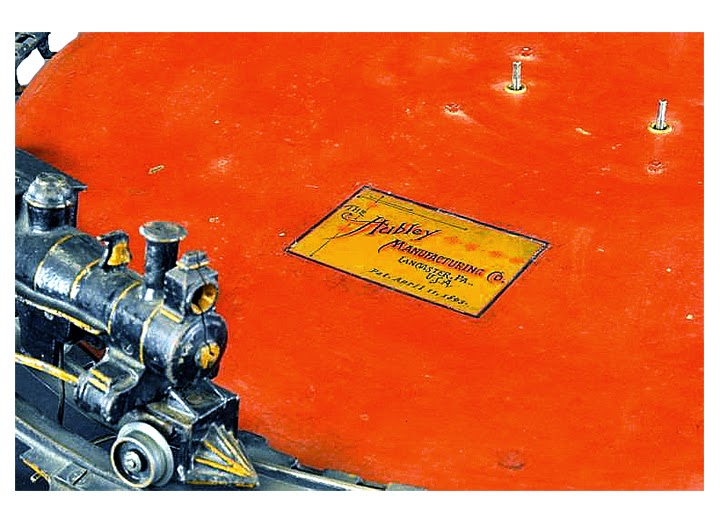Monday, March 31, 2014
(Post # 2 of the day)
(Post # 2 of the day)
A Fine Toy
from a Fine Auctioneer
Earlier in the week, I finally saw a nice listing of a toy that had been on my mind for a long time. The toy was an Electricar pair of race cars and tracks made by the KoKoMo Stamped Metal Company of Kokomo,Indiana (USA). The auctioneer is Case Antiques of Nashville and Knoxville, Tennessee, (USA), had sold this fine toy in 2012. I had originally written to Mr. Case, and I assume that he forwarded the letter to Sarah Campbell Drury, the Vice President of Fine and Decorative Arts, of Case Antiques Inc., Auctions and Appraisals.
Sarah Campbell Drury thanked me for my interest, and gave me the go ahead, but mentioned that I should not alter the photos too much so as to change them altogether. I assured her that I wouldn't. My reason was that if I changed a photo too much, then a bidder might compare my photos to that of the auctioneers or even Liveauctioneers, and see differences.
I always ask the collector, manufacturer, auctioneer if I may do improvements on their photos,and even sometimes have altered the background to present the toy against white. Sarah said that was alright, which gave me the idea to show everyone what I do for most photos.
All Photos Courtesy Case Antiques, Inc.
The above image is a straightforward screen capture. I use a program called SnagIt that is easy to use, and relatively inexpensive. A screen capture simply takes whatever image I see on my screen and "grab it". I then save it for later editing with my software.
When images are uploaded by anyone, they can look totally different on their screen, to that of ebay or Liveauctioneers. On the host computer, the images may look great,but downloaded elsewhere,they may look different. Even my improved photos may look totally different on your computer.
Case Auctioneers did an excellent job with their photography. There are 11 photos, superbly styles (composed and arranged), in focus, and properly colour-balanced.
On my computer the photos are slightly reddish and appear underexposed. Also there are a few small pieces of dust from the toy, some minor scuff marks, and some small circular blurs caused by dust on the CCD (the image sensor that captures photos nowadays. Before, that was done with film.
In the photo above, you'll notice that I've added the Case Auctioneers Logo,and the copyright notice.
The photo above illustrates what I did. As I mentioned, this photo may looked totally different on your computer. I removed some of the dust marks, scuff marks,and dust, whitened the background, adjusted the exposure, and removed a bit of red from the photo.
What I will say, without a doubt, is that I wouldn't hesitate for a milli-second to bid on an item from Case Auctioneers or any seller, dealer or other auctioneer who had slightly imperfect photos. Most people base their bids on the reputation of the person or dealer, and the description. Also, you can always ask for more photos,or phone the company if you have any questions.
I'm sure by now, you've come to realize that with so many photos, you know that this company is very professional when it comes to selling. What I easily see and admire is that they have people who are well-experienced in composing their items for being presented to the viewer. I'm sure many of their specialist are usually on the photo shoot to ensure everything is photographed well!
With the above photo, I did what is called "dodging". I t's an old photographic darkroom term, and today simply means that I lighted up an area. In this case, it was the motor parts under the car frame.
What I like about these KoKoMo Electricars is how simple the mechanical and electrical system, but how well they were built. Also, these would be exceptionally easy to restore, if someone wanted to do so.
Again , I dodged the underside to show you the motors better. I haven't changed anything,but just lighted the area. in the studio, it would a simple matter of adding more light via an extra studio light or silver cardboard reflectors.
Here's a great close-up showing how the electricity was picked up by the front silver rod. From there, the wires transmitted the electricity to the motor and allowed the gears to move the tires and wheels.
This is great photography skills, with great photos to illustrate how this KoKoMo Electricar actually worked. I would assume that there was a transformer that powered the steel track, and with that would allow the cars to speed up or slow down.
Now if someone out there has more information on this Indiana company, please write to me. I'd like to know more about the company , this fine car set, and of course, if the company made other toys.
Thanks for dropping by,
and as always,
have a great part of the day or night,
wherever you may be.
Stacey
please feel to write me at:
toysearcher@gmail.com












.jpg)









































